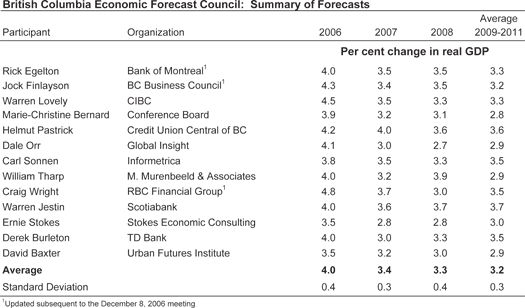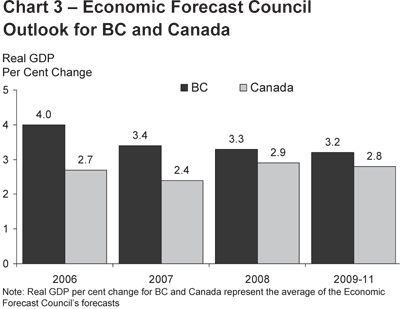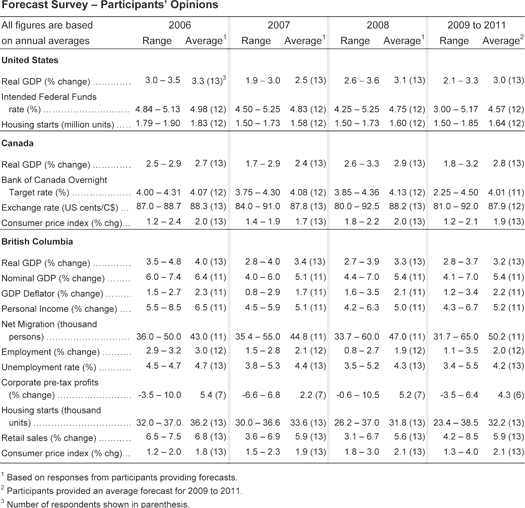The Economic Forecast Council, 2007
Introduction
As a requirement of the Budget Transparency and Accountability Act, the Minister of Finance seeks the advice of the Economic Forecast Council (the Council) every year on the outlook for the
provincial economy. This consultation process takes place prior to the budget and the resulting Council forecasts are presented
each February when the budget is delivered.
The Minister met with Council members on December 8, 2006 to discuss their estimates for 2006 as well as the economic outlook
for 2007 and beyond. Participants each provided information for the individual years 2006, 2007 and 2008 as well as an average
forecast for the years 2009 to 2011.
Council members discussed their views on BC's near-term economic outlook and on factors affecting the province's medium-term
outlook. Among various topics discussed were the international outlook, commodity prices, the continued demand for skilled
labour, as well as the tourism, forestry and construction sectors. This was followed by discussions on health care spending
and the economic impacts of the 2010 Olympics.
Forecast details from the Council surveys are summarized in the table at the end of this topic box.

Overview
The Council's estimates for economic growth in British Columbia in 2006 averaged 4.0 per cent, while its forecasts for future
growth averaged 3.4 per cent for 2007, 3.3 per cent for 2008 and 3.2 per cent for the 2009 to 2011 period. Council members
anticipated strong growth in BC over the next few years relative to the other Canadian provinces, and that BC's economy would
outperform Canada's through 2011.
Participants expected domestic demand to continue as the main source of growth for BC in the near-to-medium-term. Key economic
drivers include strong employment gains, healthy consumer spending, steady housing activity, and continued strength in non-residential
construction. Council members expect a strong domestic economy to be supported by several other factors including continued
demand for BC's natural resources, growing trade with Asia and the provincial government's improved fiscal position.
The Council encouraged the provincial government to maintain its healthy fiscal situation and to focus policies on skills
training and productivity.
The primary risk to the forecast noted by Council members is the softening of the US economy, as a slowing US housing sector
could hinder economic growth south of the border. Medium-to-long term forecast risks include the impact of the Mountain Pine
Beetle infestation, commodity price volatility, the rising cost of construction projects, growth in health spending, and demographic
trends that are expected to put further pressure on BC's labour supply.
International Outlook
The Council's estimates for US growth averaged 3.3 per cent for 2006, while its forecasts for US growth averaged 2.5 per cent
for 2007, 3.1 per cent for 2008, and 3.0 per cent for the 2009 to 2011 period.
Despite a weaker housing sector, most Council members felt that the overall US economy would continue to grow at a reasonable
pace in 2007 and 2008.
Council members anticipated global growth to remain robust, especially in Asia and other developing countries. Some participants
expected continued strong economic growth and high demand in China and India, while others noted growing domestic demand developing
in Latin America and Eastern Europe.
The Canadian Economy
After seeing the Canadian economy benefit from high commodity prices and continued strength in domestic demand in early 2006,
the Council was in agreement that Canada will experience slower growth in 2007, brought on mainly by a cooling US economy.
While most members felt that Canada would weather this storm and rebound in 2008, other members were more pessimistic, acknowledging
that a slowing manufacturing sector and high Canadian dollar would pull national growth down even further. Several Council
members pointed out that the Canadian dollar, expected to remain high in the medium-term, could continue to hurt net exports
and hinder tourism from the US.
Most Council members agreed that Western Canada will be the engine of national economic growth over the next few years. In
particular, Alberta, British Columbia and Saskatchewan will see sustained growth beyond 2007. Participants noted concern over
a general labour and skills shortage in the Canadian economy, and that large scale interprovincial migration to Alberta was
depleting the already shrinking labour supply in other provinces.
Estimates for Canadian growth averaged 2.7 per cent for 2006, slowing to an average forecast of 2.4 per cent for 2007 before
rising to 2.9 per cent for 2008. The Council's forecast then dipped slightly to a 2.8 per cent average for the 2009 through
2011 period.
The risks to Canadian economic growth in 2007 and 2008 include the softening US economy, a high Canadian dollar and worsening
labour and skills shortages.

Financial Markets
The majority of Council members expected the Federal Reserve to lower its Federal Funds rate slightly in 2007 from its present
rate of 5.25 per cent. However, one Council member noted that this cut may not be seen before a further decline in US inflation.
Council projections for the intended federal funds rate1 averaged 4.83 per cent for 2007, declining to an average of 4.75 per cent in 2008, and declining again over the 2009 to 2011
period to average 4.57 per cent.
Council members generally agreed that the Bank of Canada would hold interest rates fairly steady in 2007, with the overnight
target rate2 expected to average 4.08 per cent for the year. The interest rate spread between the US and Canada was expected to narrow
slightly on average over the medium-term. Council's forecasts for the Bank of Canada's overnight target rate averaged 4.13 per
cent in 2008, falling to 4.01 per cent over the 2009 to 2011 period.
Exchange rate forecasts averaged 87.8 cents US for 2007, a slight drop from the Council's average estimate of 88.3 cents US
for 2006. Council's predictions for 2007 ranged widely from a low of 84.0 cents up to a high of 91.0 cents. Average exchange
rate forecasts for 2008 were 88.2 cents US with nine of 13 participants expecting the Canadian dollar to appreciate in that
year. On average, the Council expected the Canadian dollar to hold fairly steady over the 2009 to 2011 period, averaging 87.9
cents US. However, Council members continued to have quite divergent views on the value of the Canadian dollar over the medium-term,
with forecasts ranging from 81.0 cents to 92.0 cents over the 2009 to 2011 period.
Council members were fairly consistent in their concerns over the possible impacts of the highly valued Canadian dollar. Several
participants noted that the high dollar is already hurting net exports and tourism in BC and Canada, and could slow economic
growth if it continues to remain high. Strong commodity prices, further depreciation of the US dollar and the US twin deficit
situation were acknowledged by some Council members as factors contributing to the Canadian dollar's sustained high value.

British Columbia Forecast
Council forecasts for BC's economic growth averaged 3.4 per cent in 2007, 3.3 per cent in 2008 and 3.2 per cent during the
2009 to 2011 period. Council members anticipated strong growth in BC over the next few years relative to the other Canadian
provinces and for BC's economy to outperform Canada's through 2011. Participants expected domestic demand to continue as the
main source of growth for BC in the near-to-medium-term. Key economic drivers include strong employment gains, healthy consumer
spending, steady housing activity, and continued strength in non-residential construction. Council members expect a strong
domestic economy to be supported by several other factors including continued demand for BC's natural resources, growing trade
with Asia and the provincial government's flexible fiscal situation.


As shown in Chart 4, most Council members' forecasts for BC growth in 2007 were between 3.0 per cent and 3.5 per cent, with
a small number of estimates on either side of that range. For 2008, forecasts were distributed fairly evenly across the 2.7 per cent to 3.9 per cent range (see Chart 5).

Council forecasts for economic growth were more uneven for the 2009-11 period. Eight participants predicted growth to be 3.2 per cent or greater for this period, while another five members predicted growth to be 3.1 per cent or lower (see Chart 6).

External Issues
The Council discussed at length the softening US economic outlook, with particular focus on the cooling housing market, volatile
energy prices and the twin deficit situation. As the US is still BC's major trading partner, a downturn in the US economy would
have a significant negative impact on the province's economic growth. However, some Council members noted that BC's diversified
export market, primarily BC's growing trade with Asia, would help to shield the provincial economy from an economic downturn
in the US.
In addition, members noted that BC is well positioned to benefit from rising demand for overseas goods in several Asian countries,
especially China. Several Council members emphasized trade opportunities brought on by the rapid growth of China's economy
and its increasing demand for commodities. Some participants noted that sustained demand from China, the US and other foreign
markets will cause commodity prices and energy prices to remain at high levels or even increase in the medium-term.
Sector-specific Issues
The Council's discussion on BC's domestic economy focused on the housing, immigration and labour markets.
Most Council members expected the housing sector to slow slightly in 2007, due in part to slowing demand. While housing starts
are projected to remain at high levels in 2007, forecasts averaged 33,569 units for that year, down from 36,208 units in 2006.
The Council's estimates for housing starts averaged 31,758 units for 2008 and 32,197 units over the 2009 to 2011 period.
On average, the Council expected total net migration to BC to rise in 2007 from 2006 levels, with forecasts averaging 44,841
people for 2007 compared to 42,973 people in 2006. Members provided a broad range of forecasts for total net migration in
2007, varying from a low of 35,423 people to a high of 55,000 people. Most participants expected total net migration to BC
to increase over the medium term, though the range of forecasts for this period is also very large. The Council anticipates
total net migration to average about 47,000 people in 2008, rising to over 50,000 through the 2009 to 2011 period.
The issue of BC's looming labour shortage was Council's primary medium-term issue, with members concerned that there may not
be enough skilled workers to complete all major construction projects planned in the next few years. These shortages may push
up labour costs and inflation and could strain economic growth. Some members also noted that demographic trends would exacerbate
labour shortages across Canada over the medium-term, as the number of workers leaving the labour force will soon be greater
than the number entering. Alberta's thriving energy and construction sectors were cited as contributing to labour shortages
in Canada and British Columbia. One member noted that Alberta's rapid expansion will place inflationary pressure on BC, as
competition for human capital will intensify and lead to wage inflation. Some Council members commented that increased immigration
and greater investment in skills training are key measures for combatting future labour shortages.
Many Council members were concerned about the impact of the softening US housing market on BC's forest industry, as US demand
for forest imports could continue to decline. Participants also discussed the Mountain Pine Beetle infestation and its negative
effect on BC's lumber industry, noting that the epidemic has spread more rapidly than anticipated and that the infestation
has accelerated lumber processing rates in the near-term.
Council members discussed the 2010 Olympics as a medium-term issue, and generally agreed that the Olympics would provide a
stimulus to BC's economic growth leading up to the games in 2010. Some members cited concerns over rising Olympics-related
construction costs and over a possible boom-bust following the games, but most members agreed there would be no major economic
downturn after 2010.
Commenting on BC's tourism industry, some Council members suggested that tourism would suffer in 2007 as the relatively high
exchange rate between Canada and the US and the introduction of strict US passport requirements could dissuade US tourists
from visiting BC. Some participants also noted that BC could invest in targeted marketing campaigns for foreign tourists and
could also sharpen the type of product available to tourists.
Some participants also touched on BC's lagging labour productivity relative to other provinces and to Canada. Members noted
that continued weak productivity growth could create major constraints on the provincial economy in the medium-to-long-term.
They agreed that the government should continue to focus on increasing productivity and skills training in the future.
Government
Council members agreed that the BC government's strong fiscal position is promising and could support future economic growth.
Participants also noted that carrying a budget surplus each year provides fiscal flexibility and would be an economic cushion
for BC against global market downturns. Some Council members recommended that continued budget surpluses should be allocated
to debt reduction.
Government spending on health care was a topic of concern among Council members. Forecasters warned that continued spending
growth at increasing rates will limit fiscal flexibility and may result in the crowding out of other government spending programs.
Forecasters called for improved communication and accountability within the health care system and emphasized the importance
of ensuring health care spending remains at a sustainable level.
